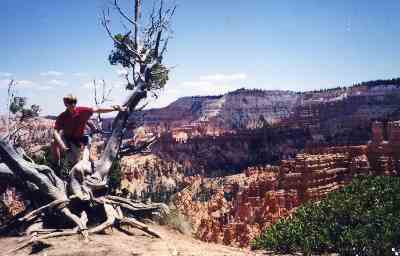
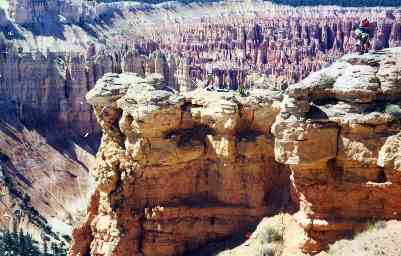
| Route 66 | Cities | Beaches |
Clothing |
Equipment |
Vehicles |
Readings |
 |
 |
| All Venture Outposts are required by their charter to conduct at least one major expedition per year to another region of the country. Many families and church youth groups would like to visit a major Western national park but are intimidated by the planning. If you're in this position, wanting to get started but lacking experience and needing a good introductory trip, we highly recommend Bryce Canyon National Park. Bryce is a great expedition because it's easy to manage but there's not a more spectacular park anywhere. Bryce is not a vast wilderness expanse. It is a small semicircular valley with a great old lodge and two fine camp grounds up on the rim. Because of the desert locale, there are no bugs. In the summer, the chance of rain is remote. A constant breeze ripples across the rim all night, quieting during the day. The main rim trail is crowded, but down in the canyon the routes are empty. With a hot, dry desert climate, you don't need to pack much --- shorts and t shirts are the 24 hour style. You'll be in a world of pinks, yellows, oranges and reds, with trees adding a little green relief. It is, as Edward Abbey once wrote, "A Festival of Light." Bryce is a three day drive from Lexington, out I-64 to St. Louis and then I-70 to Utah. Placed perfectly along the way are the KOAs at Lawrence, Kansas and Grand Junction, Colorado. We've stayed at a couple of hundred KOAs and these are two of the best 10. They have tenting sites and Kamping Kabins. They're right off the interstate. They have lots of space, wide grassy sites under huge trees, and all the usual KOA amenities. While you're in Lawrence, you can drop over and see the University of Kansas, which for us Kentuckians is like a shrine because it was the alma mater of our beloved basketball coach Adolph Rupp. | 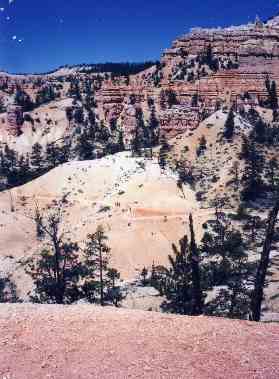 |
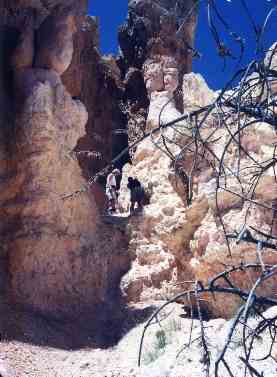 |
Grand Junction offers so many options you might want to stay over an extra night. Some of the best white water rafting in the country is available through companies that can pick you up at your campground. Colorado National Monument, the Black Canyon of the Gunnison, Orchard Mesa and the hairy mountain drive up to Telluride are all possibilities if you have an extra day to spend. And there's another choice. If you think Grand Junction is too long of a drive from Lawrence, you can stop an hour earlier at Glenwood Springs. Its attractions begin with the world's largest hot springs. There's more rafting, hiking trails and a short drive out to the ski resorts of Snowmass and Aspen. The drive from Grand Junction to Bryce Canyon is an epic, one of the most bizarre and spectacular highway trips in America. You will not only see spectacular country, but the scenery changes around every bend until your senses are overloaded. You can use up two rolls of film just on this drive. Some of the scenes are so surreal they look like you're on a foreign planet, and the fact that for long stretches you won't see any other vehicles only adds to the effect. To start this odyssey, get back on I-70 at Grand Junction (or Glenwood Springs) and follow it west into Utah. Make sure your gas tank is full. |
You could add a few days to your trip by pulling off at Thompson Springs and taking 191 20 miles down to Arches National Park. You can camp there, in Moab, or over at Dead Horse Point State Park. We like the state park, but prepare for another unreal experience if you set up camp, drive into Moab to eat or look around, then return to your campsite after dark. The road and surrounding terrain will be thick with jackrabbits, hopping around in the dark so thickly you'll be forced to slow down. But the big attraction next day will be Canyonlands National Park, Edward Abbey's favorite haunt. This is a huge expanse of high cliffs, strange rock formations, thundering rivers, 100 degree heat and reminders that Indians and outlaws frequented the area. The Arches - Moab - Canyonlands area is a center of white water rafting and slickrock biking. But if you're pressed for time, just stay on I-70 on to Exit 147 and take Route 24 South. From here all day to Bryce Canyon you'll be on a Designated Scenic Highway. Don't worry about the time. You don't have that far to go. Enjoy the show. You'll start off with a half an hour drive across salt flats between San Rafael Reef and the Henry Mountains. Then you'll turn West into Capitol Reef National Park, with the Waterpocket Fold Cliffs extending out to the South. As you come through Fremont Canyon you'll want to stop at the Indian hieroglyphics on the cliffs to your right. There's a Visitor Center worth a stop, for rest rooms if nothing else, and then you take Route 12 South. You'll climb high onto the Escalante Plateau. Along this road you'll be above and north of Glen Canyon and the Navajo Reservation. You'll want to stop frequently and look out one way or the other at the scenery far below you stretching out to the horizon. |
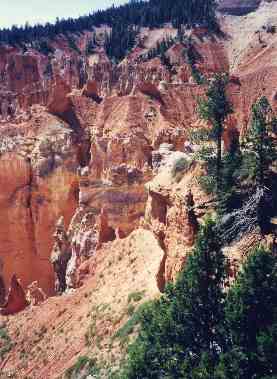 |
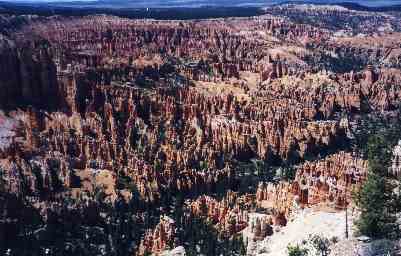 |
You'll meander your way through Dixie National Forest and past Anasazai Village State Park. Finally you'll start dropping down off the plateau, into the Kodachrome Basin and the little towns of Henrieville and Cannonville. At Cannonville Route 12 turns sharply right (North) and you suddenly find yourself looking up into Bryce Canyon. you'll wind along below the opening expanse of orange and yellow, then temporarily lose sight of it around the bend as you climb back up on the plateau. The entrance to the park is on your left. If you're staying at Ruby's Inn and Campground, it will be to your right as you approach the park gate. Just look for the huge Ute wigwams along the road. If you're staying in one of the cabins or at the lodge, they're on your left inside the gate. |
| At heart, Bryce is a day hiking paradise. You can spend a week here hiking all the different trails, never retracing your steps, coming back to your basecamp at night. And the photogenic nature of the place forces a leisurely pace. You have to stop, study, and take pictures at different angles as the sun moves across the sky. Your first day, the main rim trail is a must. It's a paved, heavily used route which climbs slowly but steadily from the lodge up to a final lookout around the other side of the circle. You need this first day to get oriented, and see all the trails winding down below you through the Disneyesque rock formations. | 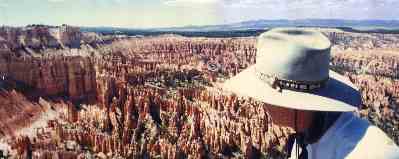 |
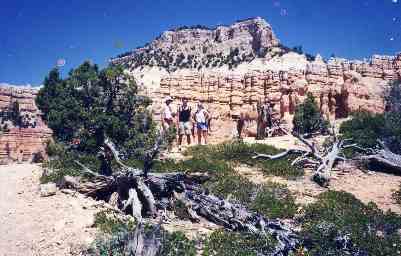 |
For the next several days, you can drop down into the valley by different routes, winding through formations like Shipwreck and The Grotto. You'll immerse yourself in a bewildering maze of hoodoos, natural bridges, spires, cathedrals, domes, and slots. You'll find a series of loop trails with connecting spurs, so you can mix and match combinations to set up whatever lengths you want. No matter where you enter or exit the trail system, you always find yourself within a few miles of the lodge or one of the campgrounds when you emerge. Whichever trail you choose, you'll be dropping far down and climbing steep switchbacks to get back to the rim, in unshaded sun, 100 plus temperatures and bright reflecting surfaces. You can take half of one day for a mule or horseback ride through the canyon on entirely separate trails. Take advantage of one of the Astronomy Nights, taking advantage of the incredibly clear and dark skies for superb viewing. |
| Trails you absolutely must hike are Rim Trail (six miles), Fairyland Loop (eight miles), Peekaboo Loop (six miles), Sheep Creek Trail (10 miles down and back, not a loop), and Riggs Spring Loop (nine miles). This will take five days. You'll need to carry tremendous amounts of water, chapstick and sunblock, and wear a broadbrimmed hat and sunglasses with sideshields. Even though you're dayhiking, backpacking boots are needed, along with several changes of socks and a can of talcum powder. These are challenging hikes. Riggs Springs in particular will be one of the more strenuous trails you've been on, even though it's mostly in Ponderosa Pine forest so you have more shade than the others. | 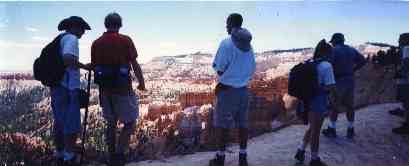 |
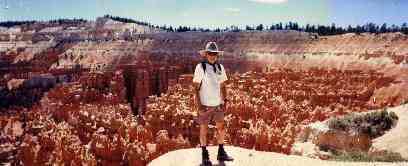 |
Bryce offers one backpacking route: the 23 mile Under The Rim Trail from Rainbow Point northward along the Pink Cliffs back to the lodge. Figure on three days and two nights. Eight camp sites are provided. You'll register for a particular site, then be required to camp there as specified on your permit. The trail is spectacular. You'll hike past cacti, blood red cliffs, sand dunes, wildflowers and purple rock formations. You'll climb 1500 feet in elevation. A $5 backcountry camping fee is levied. You cannot reserve trail permits by mail or phone, but must do so in person 48 hours in advance. The office opens at 8 am, so you can walk over from the campground your fourth day there and file the reservation. |
|
You can camp at North or Sunset Campgrounds. The group site is at Sunset for $30 per night. For a small group, you can reserve two or three adjacent regular sites. Reservations are at 877-444-6777, with a $9 fee. Both campgrounds are in Ponderosa Pine forest, with showers and laundry at the Sunrise Point General Store. There are 1928 log and stone cabins with fireplaces and full baths for $125 a night, and a motel at $115 a night per room. The lodge is a national park classic but the rooms are suites for couples or families, not really suited for youth groups. However, you should splurge your last night in the park on a meal in the lodge dining room. Ruby's adjacent to the park entrance has cabins, campsites and Ute Indian teepees, and reservations are easier to get. |
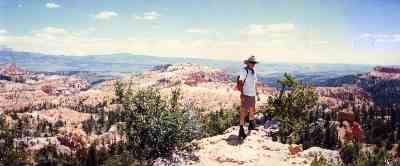 |
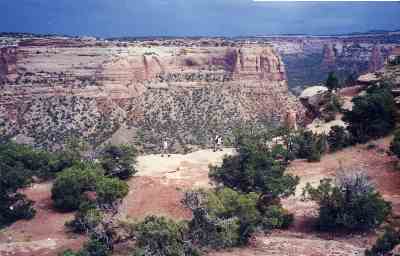 |
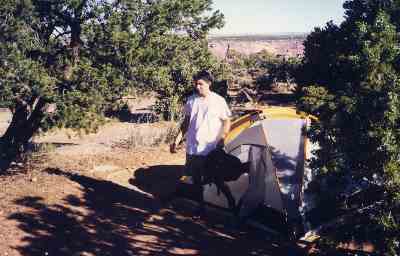 |
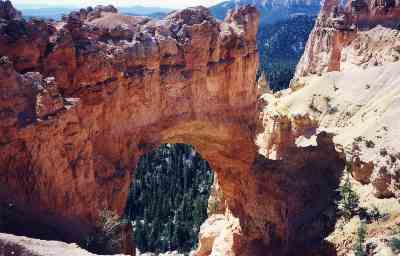 |
|
|||
|